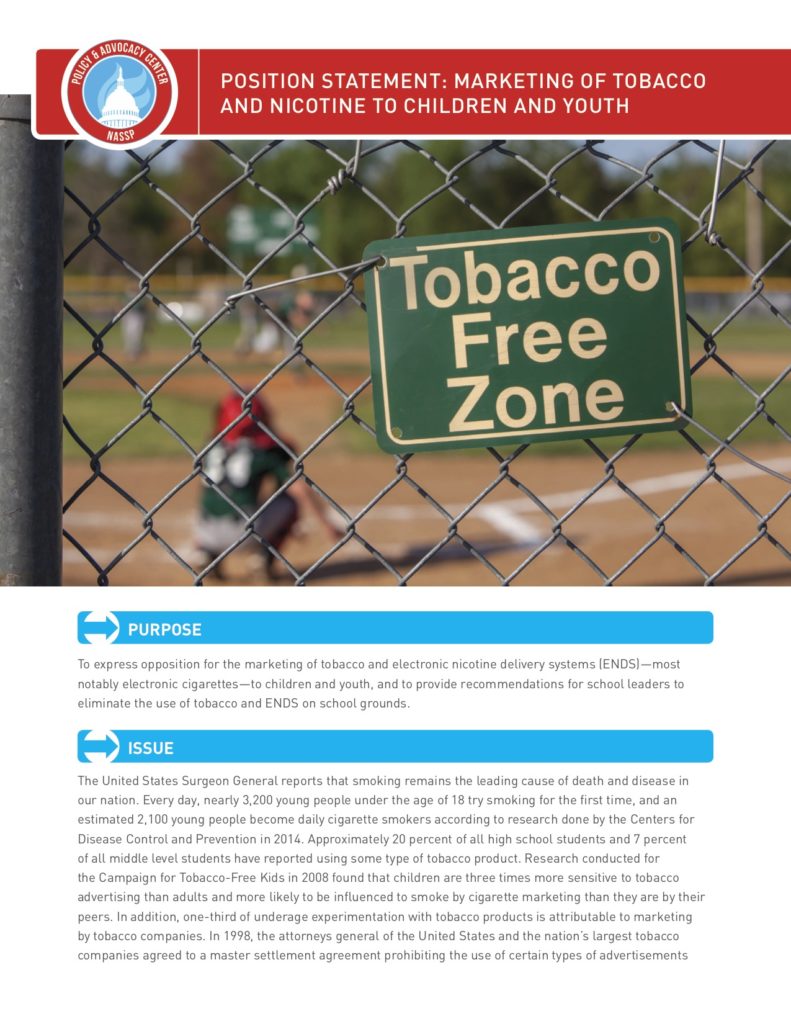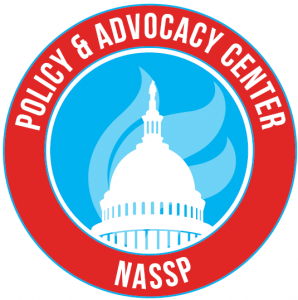To express opposition for the marketing of tobacco and electronic nicotine delivery systems (ENDS)—most notably electronic cigarettes—to children and youth, and to provide recommendations for school leaders to eliminate the use of tobacco and ENDS on school grounds.
The United States Surgeon General reports that smoking remains the leading cause of death and disease in our nation. Every day, nearly 3,200 young people under the age of 18 try smoking for the first time, and an estimated 2,100 young people become daily cigarette smokers according to research done by the Centers for Disease Control and Prevention in 2014. Approximately 20 percent of all high school students and 7 percent of all middle level students have reported using some type of tobacco product. Research conducted for the Campaign for Tobacco-Free Kids in 2008 found that children are three times more sensitive to tobacco advertising than adults and more likely to be influenced to smoke by cigarette marketing than they are by their peers. In addition, one-third of underage experimentation with tobacco products is attributable to marketing by tobacco companies. In 1998, the attorneys general of the United States and the nation’s largest tobacco companies agreed to a master settlement agreement prohibiting the use of certain types of advertisements and forbidding tobacco manufacturers from “directly or indirectly targeting youth in their promotional activities, or engaging in activities with the primary purpose of initiating, maintaining, or increasing youth smoking.” However, annual tobacco marketing expenditures are now up to $8.9 billion annually, or $24 million daily.
Even though tobacco manufacturers are no longer able to advertise to minors and the number of students using regular cigarettes has been decreasing, the number of overall underage tobacco users remains steady due to the popularity of ENDS, mainly electronic cigarettes. Approximately 11 percent of high school students and 4 percent of all middle school students have reported using electronic cigarettes in 2016, according to the Centers for Disease Control and Prevention. Electronic cigarettes pose a dangerous threat to our nation’s youth, as they are much more popular and easily accessible for minors than regular cigarettes. There is extra concern around electronic cigarettes and other ENDS as they are viewed as healthier alternatives to regular tobacco products. However, the nicotine in electronic cigarettes still poses substantial risks to our nation’s youth, as it can inhibit attention and learning developments. Minors are also more susceptible to addiction than adults, and the use of nicotine at an early age could lead to a long-term addiction, according to the U.S. Surgeon General.
In 2016, the Food and Drug Administration (FDA) finalized a rule to extend its regulatory authority to all tobacco products, including ENDS. This rule, referred to as the deeming rule, allowed the FDA to declare that electronic cigarettes and other forms of ENDS and their components to be subject to regulation under the Tobacco Act. Ultimately, the deeming rule disallows the sale of any ENDS or their components to minors, and requires manufacturers to register their products with the FDA in order to sell them legally.
Despite all 50 states and the federal government banning the sale of ENDS to minors, the Public Law Health Center found that many minors have still exploited loopholes to gain access to these devices. This issue is compounded when examining the marketing of electronic cigarettes. Many of these products feature bright colors and fruit, candy, and/or alcohol or other flavors that youth find attractive and interesting. Overall, 85 percent of electronic cigarette users from ages 12–17 use flavors. The Department of Health and Human Services also found that in 2014, about 7 in 10 middle school and high school students had seen some sort of electronic cigarette advertisement.
Guiding Principles
NASSP is uncompromising in its commitment to the intellectual growth, academic achievement, character and leadership development, and physical well-being of youth. The negative health implications of tobacco and nicotine use are irrefutable. Sales and marketing of tobacco products and ENDS to minors must remain illegal and relevant laws must be enforced.
Educators have a responsibility to teach students about the harmful effects of tobacco and nicotine use and to model good behavior.
All schools should provide a tobacco- and nicotine-free learning environment.
Recommendations
Recommendations for Federal Policymakers
- Policymakers should grant the U.S. Food and Drug Administration the authority to regulate the manufacturing, marketing, and sale of tobacco products.
- Policymakers should restrict all forms of tobacco and nicotine advertising and promotions that result in increased use of tobacco or nicotine products by minors, in addition to bans on the sale and marketing of tobacco and nicotine to youth.
Recommendations for State Policymakers
- Policymakers should limit all advertising of tobacco and nicotine products within 1,000 feet of schools.
- Policymakers should pass legislation that would outlaw the use of tobacco products or ENDS on all private and public school properties, as was recently done in New York in July 2017.
Recommendations for District Leaders
- Policies related to tobacco should be updated to include ENDS and address the concerns surrounding them.
- The use of tobacco products and ENDS should be prohibited in school districts.
Recommendations for Principals
- Principals should educate and mentor students about the dangers of tobacco and nicotine, and teach them how to resist social influences to smoke.
- Principals should prohibit smoking or vaping by anyone on school grounds.
- Principals should provide anti-smoking and anti-vaping education to all middle level and high school students.
Resources
- Campaign for Tobacco Free Kids. (2008a). A decade of broken promises: The 1998 state tobacco settlement ten years later. Retrieved from www.tobaccofreekids.org
- Campaign for Tobacco-Free Kids. (2008b). Toll of tobacco in the United States of America. \[Fact sheet\]. Retrieved from www.tobaccofreekids.org
- Centers for Disease Control and Prevention. (2008). Cigarette use among high school students—United States, 1991-2007. Retrieved from www.cdc.gov/
- Centers for Disease Control and Prevention. (2006). Youth and tobacco use: Current estimates. Retrieved from www.cdc.gov/


